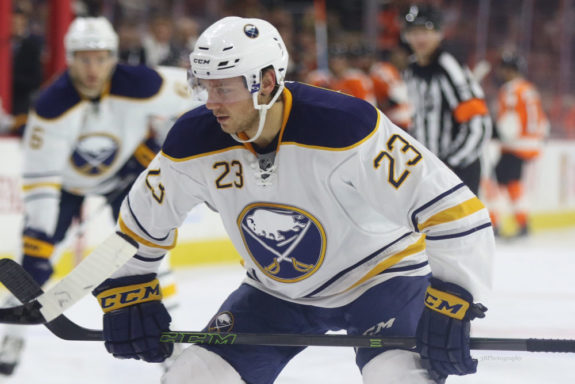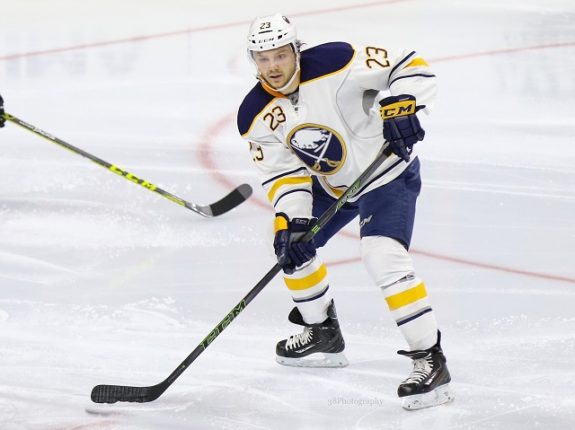Believe it or not, the Buffalo Sabres have played pretty well lately. Sure, the pressure has been off for months, but instead of coasting into the offseason, certain players have brought their game to the next level. One of them is the ever-polarizing Sam Reinhart.
Since struggling to produce early in the season, the 22-year-old has been on fire as of late. After Phil Housley realized what everyone else already knew, he decided that Reinhart belonged on the wing after trying to force him in as a center to start the year. With 29 points in his last 27 games, he remains red-hot as he approaches restricted free agency.
The Jack Eichel Wingman Myth
At the beginning of the season, if you were to type the word “snakebitten” into a Google search, Reinhart’s face would have popped up. With a paltry five points in the first 16 games of the 2017-18 campaign, he quickly became the subject of trade speculation. With a pedestrian 40.3 faceoff percentage, it appeared that the former second overall draft pick would never be more than a complimentary player, riding shotgun with a strong center.

In 2016-17, he was quite productive while attached to Jack Eichel’s hip. In 79 games he posted a career-high 47 points playing on the right side. After failing to acclimate to his new role this season, fans began to wonder if he could ever be productive sans Eichel.
On Feb. 10 against the Boston Bruins, Eichel took a nasty spill into the boards, resulting in a high ankle sprain that would leave him sidelined for 15 games. Leading up to the injury, Reinhart was having his most productive stretch of the season. It felt like a foregone conclusion that his production would come to a screeching halt with Eichel out of the lineup.
Quite the contrary. Reinhart has been credited with 12 points since Buffalo lost their franchise cornerstone. To the delight of the blue-and-gold faithful, his game continued to elevate while serving beside veteran center, Ryan O’Reilly. Most importantly, he continues to produce a healthy amount of his points while serving as a net-front presence.
“It’s amazing, he always seems to be there,” said O’Reilly. “He’s so strong in front, the guys can’t seem to get him out of there and obviously he has great hand-eye too.”
Incidentally, since having Reinhart on his wing, O’Reilly has experienced a jump in production as well, tallying 13 points in 15 games. In fact, the two have played so well in tandem, that Housley elected to keep them together even after Eichel returned to the lineup.
Reinhart’s Consistency
While Reinhart’s second half has certainly been impressive, the question remains; can he produce on a consistent basis? If he keeps up his current pace, he will just barely eclipse his career-high point total. The Sabres final 10 games of the season will be crucial for him. If he can indeed maintain the better-than point-per-game clip he has managed over the past couple months, he will make Jason Botterill’s decision this summer that much more difficult.
Botterill has two options. He can either try to sign his best winger to a bridge deal or lock him down long-term. If he decides to pursue a bridge contract, he can keep the team’s salary cap in check while retaining one of his few talented forwards.
Should he determine that Reinhart’s strong play is more than an apparition, a long-term deal would keep a potential point-per-game threat locked down with a manageable salary that he could certainly surpass in terms of value.

The Sabres have just over $39 million tied up among nine forwards heading into the 2018-19 season (not factoring in a potential Matt Moulson compliance buyout). With Eichel, O’Reilly and Kyle Okposo accounting for $23.5 million over the next four years, the team would be best suited retaining Reinhart on a short-term contract.
Buffalo has too many long-term expensive deals on the books, many of which belong to underachieving forwards. They simply cannot run the risk of Reinhart regressing back to the half-point-per-game rate that he has maintained over the course of his three-year career. Though they could potentially lose him 2-3 years down the line, the Sabres do not have the cap room to spend on another long-term forward contract on a roster with so many holes.
Related: Sabres Season Still Has Value
The Sabres Improved Play
Reinhart isn’t the only Sabre who has stepped up lately. Over the last 18 games, Buffalo is 9-8-2. Not bad for a team that will almost certainly finish at the bottom of the Eastern Conference for the third time in five years. As fan expectations have dissolved immensely since the start of the season, they have played a much more wide-open, attack-oriented game.
It was expected that the team would go through some growing pains while transitioning from the “play not to lose” strategy employed by Dan Bylsma, but hardly anyone thought it would take this long. Of course, it’s much easier to perform when nobody expects you to succeed, so it’s tough to determine whether Housley’s system is finally clicking, or if his squad is playing a more relaxed game at the conclusion of another lost campaign.

Another reason for the Sabres’ recent improvement could be the influx of talent from their AHL affiliate, the Rochester Amerks. Players like Brendan Guhle, Nic Baptiste and Casey Nelson have performed very well, infusing a level of speed and effort the Sabres have sorely missed this season. Guhle and Nelson, in particular, are key cogs in the organization’s future on the back-end.
Buffalo has seven upcoming restricted free agents this summer, several of whom have shown promise during the home stretch, including Baptiste and Nelson. Botterill will have to assess which of them can put forth the same effort and production on a consistent basis. That will be the biggest determining factor in who stays, and who goes as he tries to drag this franchise up from the NHL basement.